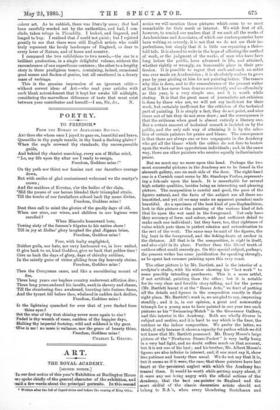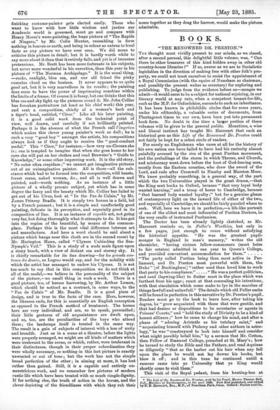AR T.
THEROYAL ACADEMY. [SECOND NOTICE.]
-In our first-notice of this-year's'Exhibition at BirrlingtonlIonse ma spoke chiefly ofthe general character of the exhibition, and :-said a fewworda about the 'principal portraits. In this-second
notice we will mention those pictures which seem to us most remarkable for their merit or interest. We wish first of all, however, to remind our readers that if we omit all the works of Academicians and Associates, of which our contemporaries have been writing so severely, it is not that we do not see their imperfections, but simply that it is little use repeating a thricetold tale. It is absurd to write in the hope of affecting the method of work, or the judgment of the works, of men who have been long before the public, have advanced in life, and attained, whether rightly or wrongly, an honourable place in their profession. It is possible to regret that such-and-such an artist was ever made an Academician ; it is absolutely useless to go .on year by year girding at him for not painting better. The reason why this is done, and to the remembrance of the present writer at least it has never been done so consistently and so offensively as this year, is a very simple one, and it is worth while stating. It is that the great mass of journalistic art criticism is done by those who are, we will not say inefficient for their work, but certainly inefficient for the criticism of the technical part of painting. It is simply a fact, they do not paint, and nine times out of ten they do not even draw; and the consequence is that the criticism when good is almost entirely a literary one. But a certain amount of technical remark is insisted on by the public, and the only safe way of attaining it is by the selection of certain painters for praise and blame. The consequence is that there are always one or two scapegoats in the Academy who get all the blame which the critics do not dare to bestow upon the works of less opprobrious individuals ; and, in the same way, there are other painters who receive equally indiscriminate praise.
But we must say no more upon this head. Perhaps the two most successful pictures in the Academy are to be found in the -eleventh gallery, one on.each side of the,door. The right-hand 'one is a Cornish coast scene by Mr. Stanhope Forbes, represent.. ing a fish-sale upon the beach. It is remarkable for several high artistic qualities, besides being an interesting and pleasing picture. The composition is careful and good, the pose of the figures naturalsand the facts of the ,subject are all there unbeautified, and -yet (if we may make an apparent paradox) made beautiful. As a specimen of the best kind of pre-Raphaelitism, look in this picture at the painting of -the various kind of fish that lie upon the met sand in the foreground. Not only have they accuracy of form and colour, iwith just sufficient detail to make each one individual ; but they-have, too, that rightness of -value which puts them in perfect relation and subordination to the 'rest of the work. The same 'may .besiaid of the figures, the big boat in the foreground, and the fishing-boats at anchor in the distance. All that is in the composition, is right in itself, and also 'right in its place. Further than this literal truth of outdoor effect could scarcely go. On this special subject, perhaps, the present writer has some justification for speaking strongly, as he spent last summer painting upon this very coast.
The other picture is by Mr. Bartlett, and is the interior of a sculptor's studio, with his widow showing his "last work " to some possibly intending purchasers. This is a more artful, if not artificial, painting than the other ; but it is notable for its very clear and forcible story-telling, and for the power (Mr. Bartlett learnt it at the " Beaux Arts," we fear) of putting all the details and figures in the composition exactly in their -rightplace. Mr. Bartlett's work is, we are glad to say, improving steadily ; and it is, in our opinion, a great and noteworthy triumph for a young man to have painted in one year two such pictures as his " Swimming:Match " in the Grosvenor Gallery, and this interior in the Academy. Both are wholly diverse in subject and motive, and it is hard to say which is the finer, the outdoor or the indoor composition. We prefer the latter, we think,if only because it shows a capacity for pathos which we did not knowthatMr. Bartlett possessed. Mr. Henry Moore's large picture cifthe"' Newhaven Steani:Packet" is very badly hung in a verybad light, and no doubt suffers much on that account, but it is not one of his best ; and his brother;Mr. Albert Moore's figures are also inferior in interest, and,if one must say it, show less patience and 'beauty than usual. We-do not say that it is, -bat it seems-as if it were, the case;'that these painters have lost 'heart •at..tlie -persistent 'neglect 'with which •the Academy has treated them. It would-be-worth while.getting angry about, if it 'were any use being angry 'with the official actions of the Academy, that the best sea-painter in -England and the _most cskilful of • the classic licieraistive artists should not belong to R.A.'s, when every blundering Scotchman and finicking costume-painter gets elected easily. Those who want to know with how little wisdom and justice our Academic world is governed, must go and compare with Henry Moore's wave-painting, the huge picture of "The Rapids of Niagara," by Mr. Cohn Hunter, resembling in form nothing in heaven or earth, and being in colour as untrue to local facts as any picture we have ever seen. We did mean to criticise this picture in detail; but it is hardly worth while to say more about it than that it entirely fails, and yet is of immense pretensions. Mr. Brett has been more fortunate in his subjects, but never more wonderful in his execution, than this year in his picture of " The Norman Archipelago." It is the usual thing, —rocks, sunlight, blue sea, and our old friend the pinky cumulus cloud on the horizon. It never appears to us quite good art, but it is very marvellous in its results ; the painting does seem to have the power of imprisoning sunshine within the limits of a frame. Of course it is faney,but one thinks that this blue sea and sky light up the pictures round it. Mr. John Collier has forsaken portraiture (at least as his chief work) this year, and sent a composition, chiefly of a woman's back and a tiger's head, entitled, "Circe." Like all his later painting, it is a good solid work from the technical point of view, well drawn, and carefully if not brilliantly painted. Perhaps it is the absence of what the French call L'imprivu which makes this clever young painter's work so dull ; he is such a very "good boy" amongst the artists, his compositions always look as if they ought to receive the " good-conduct medal." This " Circe," for instance,—how very un-Circean she is ; one is tempted to imagine that when she goes home to her cave she will put on her clothes and read Brewster's " Guide to Knowledge," or some other improving work. It is the old story, " Ne gator ultra crepidam ;" we cannot get imaginative pictures out of an unimaginative painter. All is there—all the substance which had to be formed into the composition, wild beasts, forest scene, naked woman, &c., and all is well drawn and painted, and—worth nothing. As an instance of a little picture of a wholly prosaic subject, yet which has in some degree the fancy and the beauty which Mr. Collier has failed to get out of his Circe, look at " In the Pas de Calais," by Mr. James Prinsep Beadle. It is simply two horses in a field, led by a French peasant ; but it is a simple and unaffectedly good painting, delicate in its perception, and especially good in its composition of line. It is an instance of capable art, not going very far, but doing thoroughly what it attempts to do. It has got into the region of the beautiful, by means of the commonplace. Perhaps this is the most vital difference between art and manufacture. And here a word should be said about a picture which hangs near this (both are in the second room) by Mr. Harington Mann, called " Ulysses Unbinding the SeaNymph's Veil." This is a study of a nude male figure upon a stony beach, with a view of distant sea and stormy sky. It is chiefly remarkable for its fine drawing—for les gran& contours du design, as Legros would say, and for the nobility with which the artist has managed to endow his Ulysses. It is not too much to say that in this composition we do not think at all of the model,—we believe in the personality of the subject of the picture,—no small thing in such a work. There is a good picture, too, of horses harrowing, by Mr. Arthur Lemon, which should be noticed as a contrast, in some ways, to the " Pas de Calais " of Mr. Beadle. It is a good piece of design, and is true to the facts of the case. Here, however, the likeness ends, for this is essentially an English conception as opposed to the French method of treatment. The horses here are very individual, and are, so to speak, personified ; their little gestures of old acquaintance are dwelt upon, and so, too, are the peculiarities of the boys who attend them ; the landscape itself is treated in the same way. The result is a gain of subjects of interest with a loss of unity and breadth. Just as in a scene at a theatre, before the lights were properly arranged, we might see all kinds of matters which were irrelevant to the scene, or which, rather, were irrelevant in their distinctness, though in their proper subordination they were wholly necessary, so nothing in this last picture is exactly unwanted or out of tone ; but the work has not the simple broad perfection of the other ; in aiming at more, it has lost rather than gained. Still, it is a capable and entirely unmeretricious work, and we remember few pictures of modern rustic life which have been treated with so much simple dignity. If for nothing else, the truth of action in the horses, and the clever depicting of the friendliness with which they rub their
noses together as they drag the harrow, would make the picture admirable.



































 Previous page
Previous page